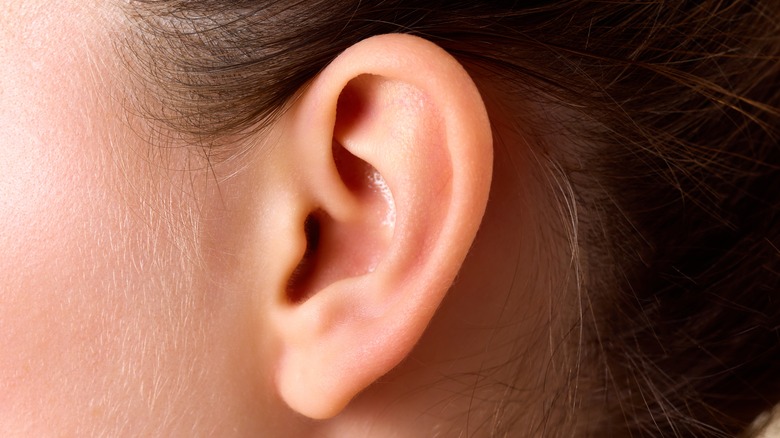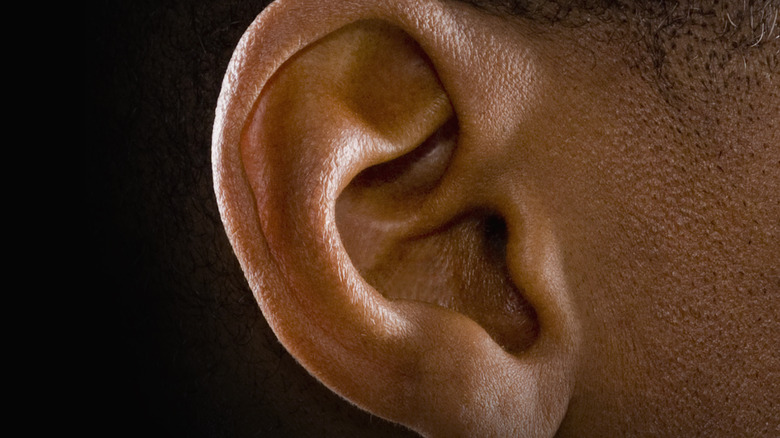Here's Why Some People Can Wiggle Their Ears But Others Can't
We've all surely met someone who has the ability to move their ears, but why is such a thing so rare? One of the most interesting vestigial structures in our bodies are the auricular muscles. These muscles surround the ear and attach to the skull and scalp, with the auricularis superior extending from the top of the ear, the auricularis anterior extending from the side of the ear towards the face, and the auricularis posterior extending from the back side of the ear towards the back of the head. Today, these muscles are considered vestigial, meaning they once served a significant function which they no longer do. In fact, the auricular muscles were once indispensable to us human beings, as they helped protect our ancestors who used the muscles to change the shape of the pinna or auricle, which refers to the outer ear. This would help funnel sound to the eardrums — a pretty useful ability for remaining aware of where potential predators might be hiding.
Humans have multiple vestigial structures in our anatomy, from our coccyx to our appendices and the "useless" organ that's actually more important to our health than we thought. But just because something is considered vestigial, that doesn't mean it's useless. Far from it. Biologists view vestigial structures as those which no longer carry out their primary function but continue to carry out other functions within the body. That's no different with auricular muscles. A 2025 study in Frontiers in Neuroscience found that these muscles actually activate when we're listening intently, especially when there are competing sounds, suggesting these vestigial muscles are part of a mechanism that helps us pay attention, rather than simply being engaged as a reflex.
That said, few humans are able to use the auricular muscles to actually move their ears any more. Our ancestors lost this ability around 25 million years ago — roughly the same time they started to lose their tails. There are, however, some individuals who can still use this muscle group to pull the ears up and back. But why?
How common is voluntary ear wiggling in humans?
It's not entirely clear why the auricular muscles became vestigial, though like all vestigial structures, they are an example of evolutionary adaptation. One explanation provided by experts is that our visual and vocal systems evolved to a point that we no longer needed the ability to move our ears in order to survive, and so we simply evolved beyond using these muscles. That said, not all of us lost this ability entirely. Recent studies, such as the 2025 Frontiers in Neuroscience study, have shown that the auricular muscles might be more active than we realized for all of us, but even then this activity is mostly involuntary. What's more, our auriculomotor system is simply attempting to work after becoming vestigial 25 million years ago, and is nowhere near as effective as it once was. Some individuals have, however, retained voluntary and obvious control over this vestigial element.
In 1995, researchers carried out a study which was published in the journal Perceptual and Motor Skills. It involved 442 subjects (204 men and 238 women) and found that 22% could move one of their ears — roughly 18% could move both ears at the same time. Interestingly, it was found that significantly more men could move both ears simultaneously.
Why is it that only a small proportion of people retain conscious control of their auricular muscles? Well, it comes down to the facial nerve and the neural pathways connecting to these vestigial muscles.
Why can only some people wiggle their ears?
The temporal branch of the facial nerve and the posterior auricular nerve provide the nerves for the auriculares muscles. But the white matter pathways required to activate the nerves controlling these ear muscles are dormant in most people. White matter is the name given to regions of the central nervous system that facilitate communication between regions of the brain and between the brain and spinal cord. In people unable to wiggle their ears, white matter pathways allowing for voluntary control of the auricular muscles are dormant. But for whatever reason, some people have white matter pathways that remain active, giving them control over these vestigial muscles.
This is likely the simple result of how our anatomy has evolved over time. Not everybody is going to lose specific neural pathways at the same time, and it seems some people have retained the specific pathways that allow for voluntary ear movement. Interestingly enough, such a thing might also come with a hidden advantage. According to one 2014 study published in the journal Medical Hypotheses, ear wiggling may even be advantageous to those recovering from a brain injury, activating and promoting advanced recovery after such an incident. The researchers noted that ear wiggling is a motor task requiring a deep level of thought. Motor tasks requiring such thought had previously been linked to determining the brain's ability to repair itself. So, if you can wiggle your ears, it might be more than a neat party trick.


